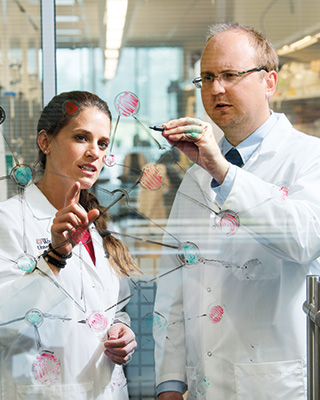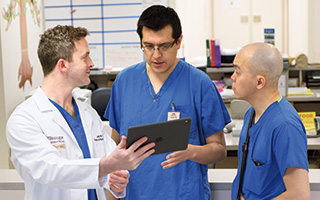Technique addresses amputee nerve pain

Since 2001, U.S. soldiers have undergone more than 2,200 major upper- and lower-limb amputations because of war injuries. But their problems don’t end with the fitting of a prosthesis and care of the residual limb. Pain typically persists.
The pain comes from neuromas — balls of regenerated nerve cells that form on the end of a cut nerve. Neuromas are a frequent complication of the most common amputation technique, called traction neurectomy, which involves cutting the nerve and relocating the remaining nerve ending to an area more protected by muscle and soft tissue. If the nerve ending regenerates in a disorganized way, it forms a neuroma.
“These service members get their amputations in the battlefield or at a foreign military hospital,” says Amy Moore, MD, a Washington University plastic and reconstructive surgeon at Barnes-Jewish Hospital who both treats and studies neuromas. “They can develop painful neuromas and then require a corrective surgery before they can wear a prosthesis.”
She and her colleagues found a potential solution while studying a different but related topic: the process of using chemically processed nerve tissue to bridge gaps in injured nerves. In the lab, they noticed that processed grafts seemed to accelerate and then slow the nerve growth that, in this situation, is desirable for re-establishing nerve function. They hypothesized that these processed grafts, attached to nerve endings in amputations, might help control the nerve regeneration that leads to neuromas.
In 2016, she received a grant from the Department of Defense to study the possibility.
Division Chief Susan Mackinnon, MD, the Sydney M. Jr. and Robert H. Shoenberg Chair in Plastic and Reconstructive Surgery, developed the necessary surgical technique. She and Moore have used it in about 40 people, with initial success.
Moore is collaborating with researchers at Walter Reed National Military Medical Center and the Uniformed Services University of the Health Sciences, both in Bethesda, Md., to test the technique in animal models through microscopic study and by monitoring the blood for substances that indicate pain. The long-term goal is a clinical trial.
If successful, their work could benefit more than 2 million U.S. citizens living with limb loss and those with neuromas caused by other nerve conditions.
Highlights

SURGEONS WORLDWIDE learn new techniques in peripheral nerve surgery from Washington University surgeons through the division’s online education tools and in-person visits to St. Louis. Ecuadoran hand surgeon Marco Yanez, MD, visited in April 2017, and division surgeon John Felder, MD, traveled to Ecuador in fall 2017 to perform surgeries with him and conduct training. Yanez wants to learn more about brachial plexus and nerve-transfer surgeries to help patients in his country with debilitating limb injuries. He and others can also reference a new educational website called PASSIO (passioeducation.com), developed by Division Chief Susan Mackinnon, MD, and interactive surgical education specialist Andrew Yee. The website builds on an earlier website (nervesurgery.wustl.edu) that instructed military surgeons in treating limb injuries.
FOREGOING HIERARCHY, new practices in the division’s operating rooms foster the open communication and personal accountability that is essential for patient safety. Before surgery, team members introduce themselves by first name and role. The surgeon reminds the team that the patient is the most important person in the room, and all team members refer to each other by first name. On a whiteboard, a medical student or intern writes patient data; the senior resident writes the surgical steps; and the surgeon lists needed equipment so the nursing team is aware of special requirements and has them ready to go.
A DECISION-SUPPORT TOOL under development by public health sciences researcher Mary Politi, PhD, and plastic surgeon Terence Myckatyn, MD, is designed to enable physicians and patients to make sound decisions about breast reconstruction based on clinical evidence and patient preferences.